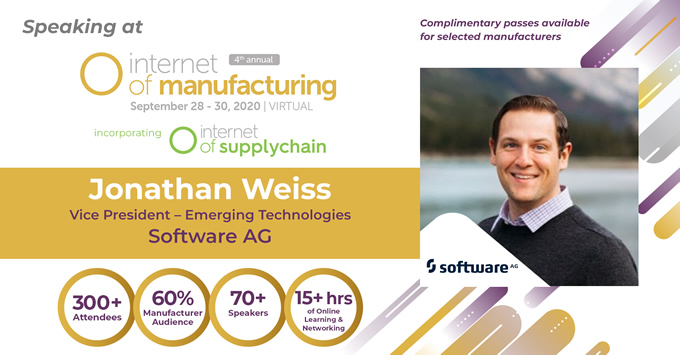September 2020 Guest Opinion: Keeping the Lights on for a “Lights Out” Future
.jpg)
By Jon Weiss, Vice President of Emerging Technologies, Software AG
How Today’s Technologies and Trends are helping Manufacturers Thrive and Redefine the Landscape of Tomorrow
There are many challenges in today’s market; the pandemic has wreaked havoc on supply chains and manufacturing operations around the globe. Deliveries are delayed, supermarket shelves are empty, products are either more expensive or completely out of stock and customers are definitely frustrated with finding even the most common household brands.
Supply chain visibility and diversification have become top priorities for manufacturers, retailers and logistic providers. Today, they are faced with challenges they never expected, but – luckily – they are using new technologies to solve them. IoT and analytics are enabling a new era of smart, connected products that often expand on the long-proven platforms of everyday products and services.
Industrial Internet of Things platforms can give them that visibility and aid in diversification of suppliers and partners. To my surprise, I am even seeing IIoT platforms beginning to replace traditional manufacturing execution systems (MES) and their applications, including production maintenance, quality, and inventory management, which are traditionally a mix of Information Technology (IT) and Operations Technology (OT). This technology is fuelling the future of an IIoT market, the size of which is predicted to reach $124 billion in 2021, according to Forbes.
This is no local or regional phenomenon; Global spending on IIoT platforms for manufacturing is predicted to grow from $1.67 billion in 2018 to $12.44 billion in 2024, with a 40% compound annual growth rate (CAGR) in seven years. However, with spending and adoption of these new technologies comes challenges.
According to a LinkedIn poll I shared with my network of professionals and experts in this space, 57% of respondents believe change management will be one of the largest challenges when driving adoption with these technologies. Processes and people will need to adapt, which is no simple task, nor is it a small undertaking. Manufacturers in the United States account for 11.39% of the total output in the economy and employ more than 8% of the workforce (nam.org).
Putting People First
Informa / Software AG released a report citing the main step to becoming fully independent on analytics is training existing employees (55%).
This leaves us with two critical needs: Upskilling existing workers and finding new talent with a specific set of technical and soft skills. A Deloitte report on Global Human Capital Trends highlighted what companies are doing to address these needs:
- Putting humans in the loop: Rethinking work architecture, retraining people to better understand business processes with holistic reasoning behind specific operations – rather than isolated focus on specific tasks.
- Expanding digital and “soft” skills: A recent World Economic Forum study found that the top 10 skills for the next decade include essential human skills such as critical thinking, creativity, and people management.
- Leveraging the digital toolbox: Along with the move toward automation, robotics, and artificial intelligence, manufacturing workers are increasingly relying on digital tools to effectively complete their work – such as digitalizing shift handover reports, KPI collection techniques, etc.
Training new employees, as compared to upskilling existing employees, is a very different thing. The “tribal knowledge” of existing employees, paired with new tooling can be extremely valuable. However, this comes with some challenges, such as retraining previously taught techniques, shifting existing mindsets to align with new processes, etc. Fresh perspectives from new employees who already possess the desired technical and soft skills solves some of the retraining challenges but this comes at a cost: Lack of knowledge about internal processes and methodologies.
Where’s the Value?
Although change management is proving to be a challenge when adopting these new technologies, it’s not the only challenge. Connectivity or infrastructure limitations, the cost of hardware and software, lack of uniformity and standards in the IoT/IIoT space and, most importantly, the lack of defined use cases and quantifiable business impacts make it very challenging to drive wide-spread adoption.
In a recent Software AG IIoT survey of over 125 North American manufacturers, although respondents placed a high value on IIoT, they are encountering serious difficulties unlocking the value of their innovation across their organizations.
Use cases that guarantee measurable, impactful results seem difficult to find for many manufacturers. The “so what?” of IIoT is a constant question companies ask. This speaks volumes to the importance of doing research, running workshops and conducting due diligence before engaging in a pilot or proof of value (POV) with any technology. It’s fun and exciting to try new things like predictive analytics, computer vision or augmented reality, but if you cannot clearly explain how these technologies are going to have a positive impact on your processes or people, adoption simply will not happen.
Attaining a “Lights Out” Future
The ideas of yesterday are quickly becoming today’s reality. I remember sitting in factories years ago, speaking with plant managers and field services teams about predictive maintenance in a similar way we would talk about flying cars from The Jetsons. The joke is on us I guess, because it is real (and got here a lot sooner than flying cars).
To ensure success when adopting these technologies, it is critical you remember to:
- Think Big. Have a long-term strategic plan and understand, fully, how the technology will impact your process, people and business. Whether it is creating a new revenue stream, increasing efficiencies, reducing quality or anything else, it is critical you spend the time to plan appropriately before beginning. Evaluating technical readiness, financial impacts and organizational appetite are just a few of the things you should consider in your planning.
- Start Small. It’s great to have a grandiose plan – in fact, it’s critical – but it is equally as critical that you start small. If your ambition is to connect a factory, start with one machine; not the entire facility, nor a whole line. Get some quick wins, prove that the concept and approach is going to work and build momentum internally to get the executive sponsorship and buy-in you need to continue the project at scale.
- Scale Effectively. Be smart about scaling out the solution to additional machines, lines and facilities. First and foremost, ensure the technology you have invested in is capable. Often you have one chance to get buy-in from users. If you introduce a piece of technology that is nonperforming or simply fails, it will be very hard to build momentum with users again. Also, get the buy-in from the stakeholders and users before implementing and mitigate your change management risks as early as possible.
As technologies like predictive analytics, computer vision, AR/VR and 5G become more attainable and more widely adopted, we will undoubtedly increase and enhance the autonomous operations in our facilities. People who were once hands-on are increasingly becoming “dashboard gurus” as they watch over autonomous operations to ensure they are being performed accurately. This is not a pipe dream. This is today’s reality.
 Jon Weiss is an innovation and technology thought leader with extensive experience in leading customer engagements.
Jon Weiss is an innovation and technology thought leader with extensive experience in leading customer engagements.
Jon has spent the last decade working with some of the world’s largest companies, including Fortune 50 organizations, seeking to undergo digital transformations in their manufacturing facilities, supply chain initiatives and enterprise applications. He has a passion for helping companies reduce cost, increase efficiency and create new revenue streams by leveraging emerging technologies.

Hear more from Jon when he presents at Internet of Manufacturing & Supply Chain Virtual on September 29, 2020.
Comments (0)
This post does not have any comments. Be the first to leave a comment below.
Featured Product

